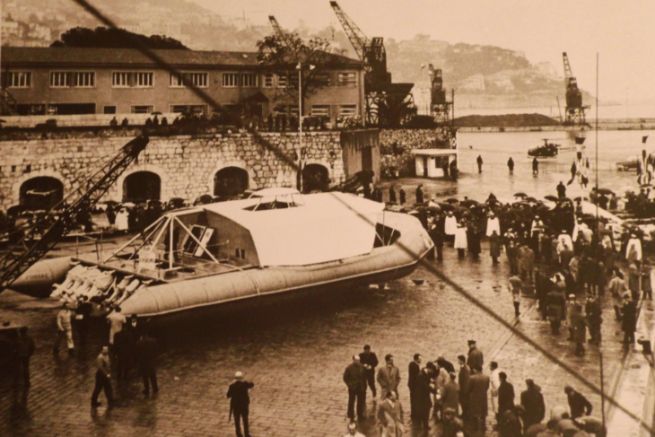
Why do we say Zodiac when we talk about a semi-rigid boat?
If you ask anyone to list the different types of boat they know, there's a good chance that among answers such as "Sailboat", "Boat", "Radar", "Catamaran" will slip an intruder: the Zodiac.
For indeed, unlike the other examples above, Zodiac is not a common name, but a trade mark, which does not prevent it from appearing in the dictionary !
But where does this curiosity come from? Why is the term "Zodiac" used for an inflatable boat?
This is what is known in French as an antonomasia, i.e. a word or expression that is a proper noun coming to replace a common noun in usage. This includes other illustrious brands such as " Typex ", " Blanco ", " Post-It ", " Frigidaire ", " Kleenex ", " Jacuzzi ", " Scotch " and many more!
While the generic term "semi-rigid boat " is the common name used in French by most brands, in everyday language, it is indeed the Zodiac term that keeps the wind in its sails!
In France, for example, the expression "Bateau Zodiac" is thus 6 times more searched for on Google than "Bateau semi-rigide", and remains 50% more popular than "bateau pneumatique"!
So how did the brand gain this notoriety and enter our vocabulary? Orca Retail answers !
A little history of dinghies
First of all, let's note that humans have known for a very long time that volumes inflated with air can help them navigate, with some sources dating their use as far back as antiquity, back then with boats made of animal skins!
But it wasn't until the middle of the 19th century that we find the first traces of inflatable boats, the ancestor of today's Zodiacs.
It was the invention of the vulcanisation process and the use of rubber by Charles Goodyear in 1839 (and the invention of pneumatics) that would lead to the creation of the first inflatable boats, since in the same year the Duke of Wellington was the very first to try out the principle.
The 1840s would then see the development of new models, with the notable example of that of the Englishman Thomas Hancock in 1840. The technique was soon used on numerous expeditions, including one to the Arctic in 1844. However, at that time, there was still no trace of Zodiac ...
The brand and inventors that would change everything
The origin of the Zodiac brand can be traced back to the year 1896, when the company"Mallet, Mélandri et de Pitray" was founded in France. Maurice Mallet, a famous aeronaut at the time, was involved in developing the production of the first airships.
It wasn't until 1909 that the band changed its name to the iconic "Zodiac". But the story doesn't end there.
It is to Pierre Debroutelle, a former airship pilot and engineer employed by the brand, that we owe the "modern" versions of the Zodiac brand inflatable boats, with an initial prototype developed in 1934.
The same year, a competitor by the name of Paul Brot marketed his own semi-rigid boats under the PB brand before joining Zodiac with his patents.
These promising initial trials were quickly validated when, in 1937, the French Marine Nationale ordered from the brand a boat capable of carrying torpedoes and bombs: this was the birth of the Zodiac and the start of its industrial-scale production.
This model takes its familiar U-shape, and features two side air chambers joined by a wooden dashboard. The patent for this model was not registered until 10 August 1943, in the middle of the world conflict.
Semi-rigid boats would mark the Second World War, enabling many airmen or sailors to save their lives once their aircraft or ship had been shot down.
The post-war period
After the war, the success of Zodiacs was not to stop, quite the contrary, as in 1950, ministerial decrees made it mandatory for inflatable rafts to be carried on board merchant vessels and all fishing boats over 25 tonnes.
Then, in 1952, another big name in sailing would put a spotlight on the brand in the person of Dr Alain Bombard(who would therefore give his name to the Zodiac competitor brand that is now well known). He then embarked on an Atlantic crossing from Tangiers to Barbados aboard a 4.30 m Zodiac christened " L'Hérétique "which would go down in legend.
The post-war period also saw the start of paid holidays and the creation of seaside resorts and the emergence of mainstream water sports. RIBs are the perfect way to enjoy the sea simply and inexpensively, and are used for rescue missions close to the coast, particularly following the emergence of the new surfing craze.
The Zodiac company then moved into the leisure industry, and very quickly the models multiplied and the brand's popularity grew, becoming entrenched in the customs and habits of French society.
 The 19.5M long Amphitrite, built in the early 1960s by Zodiac for Captain Jacques Cousteau (Source: Boatsnews.com)
The 19.5M long Amphitrite, built in the early 1960s by Zodiac for Captain Jacques Cousteau (Source: Boatsnews.com)
Zodiac in the 21st century
Today, the illustrious company is divided into two entities, " Zodiac Nautic " for leisure activities on the one hand, and " Zodiac Milpro " for military and professional use.
From holiday clubs to the US military, Zodiac is now present all around the globe, and although the RIB market now has dozens and quality competitors, language habits are probably not about to change!
Are you passionate about boating and semi-rigid boats?
Read more about the world of RIBs:
- The best semi-rigid boat accessories
- How to maintain your RIB boat
- Preparing to winterise your RIB boat
- Why buy a RIB boat? Benefits
- The best semi-rigid inflatable boat models
- Preparing to launch your inflatable boat





